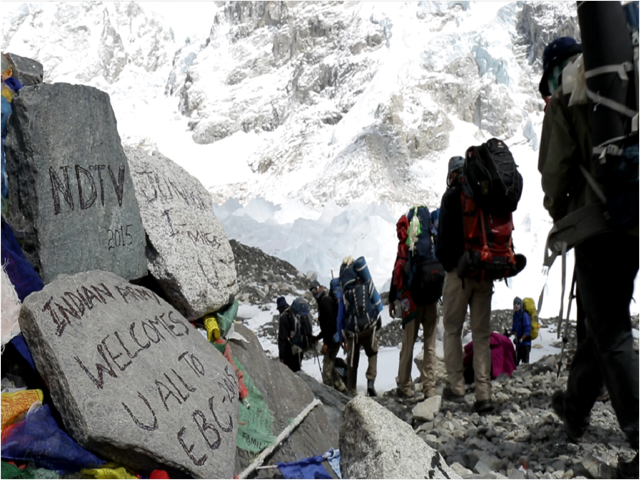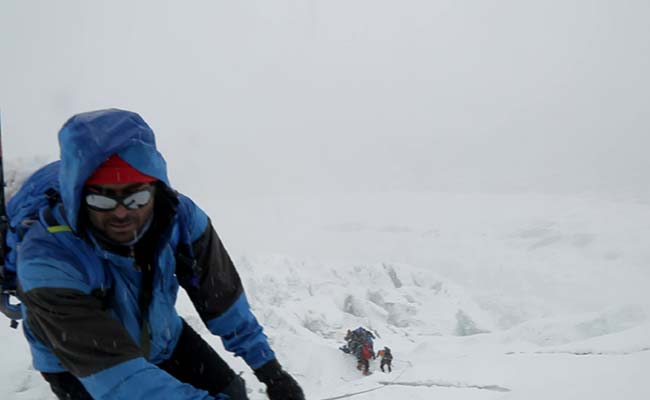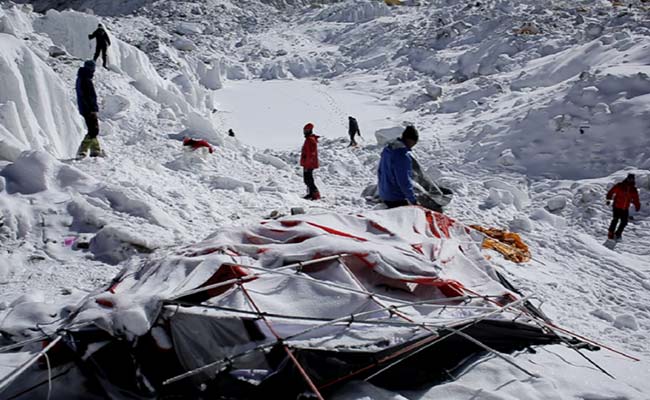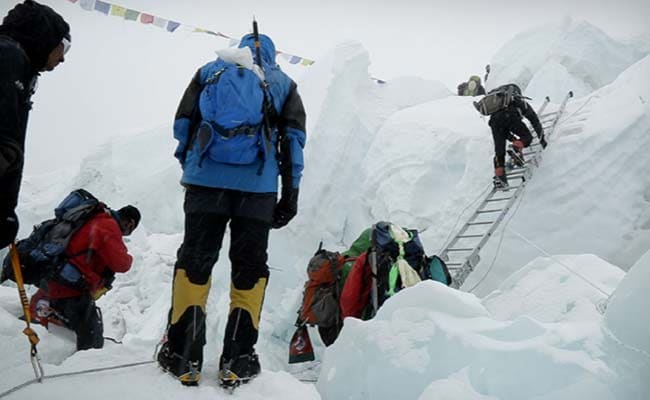
Eight months ago, I pitched an idea to film the journey to Mount Everest. When I discussed it with my colleagues, it seemed too big a project to take off, but to my surprise, the idea sounded great to our channel head, and she gave me the go-ahead.
I began my research - I read a lot of articles, watched a lot of documentaries. I got to know that the Indian army goes for an expedition every year; it took eight months for me to convince the army to take the crew and me along.
On April 4, Rakesh Solanky, my cameraperson, and I went through a feeling of mixed emotions when we boarded the flight to Nepal. We were excited about the fact that we were going to be doing something different from our daily work, something new, something that not every producer or camera person gets to shoot.

We stayed in Kathmandu for three days. Exploring Kathmandu was in itself an incredible experience. Then we headed to Lukla. At 2800 mts, Lukla is the town where most people start and finish their trek to the Everest Base Camp. Our flight was booked for 6:30 am but it was postponed to 2:30 pm because of bad weather in Lukla. Nothing could be as scary as a flight on a small twin engine through the Himalayas, from Kathmandu to Lukla, and the trepidation does not end there. The Tenzing/Hillary airport is a crazy airstrip dangling off the sides of a mountain. It is short, it is steep, and the slides slant off thousands of metres into the valley.
After this, the real journey began: from the airport, we trekked to Namche Bazaar, which is like a Swiss village situated at a height of 3,440 meters above sea level. We stopped over there to help acclimatise before tackling higher ground. Namche is known all over for its colorful, attractive market and it is the last stop where you can buy mountaineering gear. One thing that impressed me was the Irish Pubs there. They are small and cozy.
Documentaries related to Everest are screened after 3 pm at all cafes in Namche Bazaar, a good way to motivate the climbers before the actual trek.
After three days, we started the trek again. As we moved up, the temperature was dropping. The trek, the shoot, the height, it was all so challenging. I would shiver while crossing the suspension bridges. As we moved up, we gradually stopped taking baths, then washing our faces, and then even touching water.

The higher we went, things got costlier and costlier - a mineral water bottle cost Rs 300, an orange Rs 100, and to get our camera batteries charged at Debounche, we had to pay Rs 500 an hour.
After a tedious trek of 48 hours, we reached the Everest Base camp. I was spell-bound by the beauty of the white land surrounded by giant snow-covered mountains and glaciers, and covered with beautiful tents of different colours. The temperature could go down to -16 at night; it was so cold that sleeping seemed more of a nightmare. We used to fill hot water in bottles and use them to warm ourselves. Shooting the base camp and meeting people from different countries was interesting as well as challenging as the temperature would always be below zero degrees and the cold breeze made it really difficult to touch metal objects.
Before any work begins on the mountain there needs to be a Puja ceremony; this ceremony is believed to make contact with divine Sagamartha (Mount Everest) and ask Her to clear the passage for everyone. The Sherpa climbers will not climb before they are blessed thus. This happened after two days of our arrival; the pooja was quite lively with dance and music. Kukri Rum, beer and chaang made of fermented rice and grains, a type of bhaang, was distributed as prasad.
The next day I was living my dream - we went to touch the glacier and to manage a bit of acclimatisation. Suddenly, there was a huge sound, and then tons of snow hit us. At first, I did not know what had happened. Our other team mates were shouting out instructions to follow. All I knew was that I should do what I was told. A few minutes later, when it was kind of over - that's when I realised we had been struck by an avalanche.

It was not a single avalanche but multiple avalanches, as it would turn out. There were glaciers crashing down on the right and left. All we did was hold on tight to a rope while we stood on a tiny strip, trying to cover our noses and faces so that we could avoid the powdered snow flying at us, all around us.
I held the rope so tight that the gloves I was wearing almost tore. All I could see was white snow rushing towards us and nothing else. We had no option but to run for life. The path was so difficult that running was also very hard. I held on to the rope.
At that moment, I feared death. I did not want it to be my last day. I could not think of leaving my mother alone. I was her only hope. I only thought of her.
I prayed and prayed. I head others murmuring "Hare Rama Hare Krishna". There was no God that I missed praying to. I wanted to get out of this. Later, when things settled a bit, I realized there was a thick layer of snow on my body. I assume it would have been about three inches thick.
We returned to the base camp. We thought things would be better there, but it was not. Everything was completely devastated. Our tents were destroyed, our bags lost, buried deep under the snow. Sherpas were scared and crying, some people were buried in the snow and others were trying to rescue them.

I did not know what to do. I was not prepared for this. We met our other team mates at the camp and started helping other mountaineers. One of our camerapersons was injured during the avalanche. He had a head injury and was bleeding. There was blood on the snow - white snow blotted with red strains. About 20 were killed and 60 were injured due to this avalanche, and we had to help them. The weather so bad that we could not get immediate help. Through our satellite phone, we called for help.
I really wanted to call home. Knowing what had happened I wanted to tell my mom that I was fine. I really wanted to talk to her. I requested the major to let me call home and he agreed. I told her I was safe and she need not worry.
I have seen many frozen dead bodies. I may have not known them for long, but they are forever with me.
(Aamir Rafiq is a producer with NDTV Prime. He was at Khumbu glacier (between Mount Everest and the Lhotse-Nuptse ridge) when the 7.9 magnitude earthquake hit Nepal on April 25.)
The opinions expressed within this article are the personal opinions of the author. The facts and opinions appearing in the article do not reflect the views of NDTV and NDTV does not assume any responsibility or liability for the same.
I began my research - I read a lot of articles, watched a lot of documentaries. I got to know that the Indian army goes for an expedition every year; it took eight months for me to convince the army to take the crew and me along.
On April 4, Rakesh Solanky, my cameraperson, and I went through a feeling of mixed emotions when we boarded the flight to Nepal. We were excited about the fact that we were going to be doing something different from our daily work, something new, something that not every producer or camera person gets to shoot.

(Entry to the Everest Base camp)
We stayed in Kathmandu for three days. Exploring Kathmandu was in itself an incredible experience. Then we headed to Lukla. At 2800 mts, Lukla is the town where most people start and finish their trek to the Everest Base Camp. Our flight was booked for 6:30 am but it was postponed to 2:30 pm because of bad weather in Lukla. Nothing could be as scary as a flight on a small twin engine through the Himalayas, from Kathmandu to Lukla, and the trepidation does not end there. The Tenzing/Hillary airport is a crazy airstrip dangling off the sides of a mountain. It is short, it is steep, and the slides slant off thousands of metres into the valley.
After this, the real journey began: from the airport, we trekked to Namche Bazaar, which is like a Swiss village situated at a height of 3,440 meters above sea level. We stopped over there to help acclimatise before tackling higher ground. Namche is known all over for its colorful, attractive market and it is the last stop where you can buy mountaineering gear. One thing that impressed me was the Irish Pubs there. They are small and cozy.
Documentaries related to Everest are screened after 3 pm at all cafes in Namche Bazaar, a good way to motivate the climbers before the actual trek.
After three days, we started the trek again. As we moved up, the temperature was dropping. The trek, the shoot, the height, it was all so challenging. I would shiver while crossing the suspension bridges. As we moved up, we gradually stopped taking baths, then washing our faces, and then even touching water.

(The moment the quake struck. Seen here - Army team leader Major Ranvir Singh Jamwal)
The higher we went, things got costlier and costlier - a mineral water bottle cost Rs 300, an orange Rs 100, and to get our camera batteries charged at Debounche, we had to pay Rs 500 an hour.
After a tedious trek of 48 hours, we reached the Everest Base camp. I was spell-bound by the beauty of the white land surrounded by giant snow-covered mountains and glaciers, and covered with beautiful tents of different colours. The temperature could go down to -16 at night; it was so cold that sleeping seemed more of a nightmare. We used to fill hot water in bottles and use them to warm ourselves. Shooting the base camp and meeting people from different countries was interesting as well as challenging as the temperature would always be below zero degrees and the cold breeze made it really difficult to touch metal objects.
Before any work begins on the mountain there needs to be a Puja ceremony; this ceremony is believed to make contact with divine Sagamartha (Mount Everest) and ask Her to clear the passage for everyone. The Sherpa climbers will not climb before they are blessed thus. This happened after two days of our arrival; the pooja was quite lively with dance and music. Kukri Rum, beer and chaang made of fermented rice and grains, a type of bhaang, was distributed as prasad.
The next day I was living my dream - we went to touch the glacier and to manage a bit of acclimatisation. Suddenly, there was a huge sound, and then tons of snow hit us. At first, I did not know what had happened. Our other team mates were shouting out instructions to follow. All I knew was that I should do what I was told. A few minutes later, when it was kind of over - that's when I realised we had been struck by an avalanche.

(Our tents after the avalanche struck)
It was not a single avalanche but multiple avalanches, as it would turn out. There were glaciers crashing down on the right and left. All we did was hold on tight to a rope while we stood on a tiny strip, trying to cover our noses and faces so that we could avoid the powdered snow flying at us, all around us.
I held the rope so tight that the gloves I was wearing almost tore. All I could see was white snow rushing towards us and nothing else. We had no option but to run for life. The path was so difficult that running was also very hard. I held on to the rope.
At that moment, I feared death. I did not want it to be my last day. I could not think of leaving my mother alone. I was her only hope. I only thought of her.
I prayed and prayed. I head others murmuring "Hare Rama Hare Krishna". There was no God that I missed praying to. I wanted to get out of this. Later, when things settled a bit, I realized there was a thick layer of snow on my body. I assume it would have been about three inches thick.
We returned to the base camp. We thought things would be better there, but it was not. Everything was completely devastated. Our tents were destroyed, our bags lost, buried deep under the snow. Sherpas were scared and crying, some people were buried in the snow and others were trying to rescue them.

(Armymen on the way to Khumbu glacier - 3 hours from the base camp)
I did not know what to do. I was not prepared for this. We met our other team mates at the camp and started helping other mountaineers. One of our camerapersons was injured during the avalanche. He had a head injury and was bleeding. There was blood on the snow - white snow blotted with red strains. About 20 were killed and 60 were injured due to this avalanche, and we had to help them. The weather so bad that we could not get immediate help. Through our satellite phone, we called for help.
I really wanted to call home. Knowing what had happened I wanted to tell my mom that I was fine. I really wanted to talk to her. I requested the major to let me call home and he agreed. I told her I was safe and she need not worry.
I have seen many frozen dead bodies. I may have not known them for long, but they are forever with me.
(Aamir Rafiq is a producer with NDTV Prime. He was at Khumbu glacier (between Mount Everest and the Lhotse-Nuptse ridge) when the 7.9 magnitude earthquake hit Nepal on April 25.)
The opinions expressed within this article are the personal opinions of the author. The facts and opinions appearing in the article do not reflect the views of NDTV and NDTV does not assume any responsibility or liability for the same.
Track Latest News Live on NDTV.com and get news updates from India and around the world

